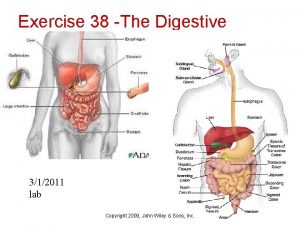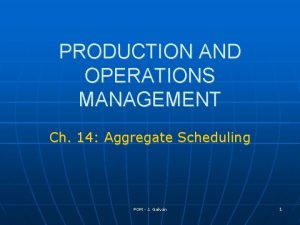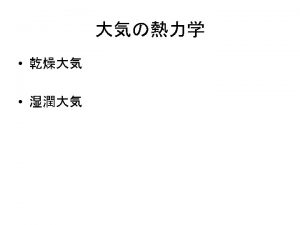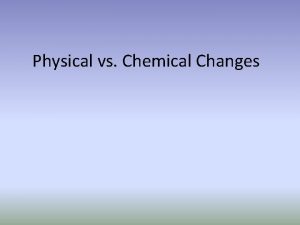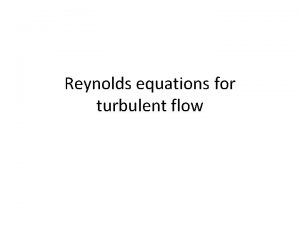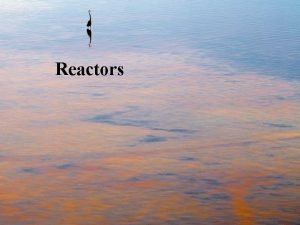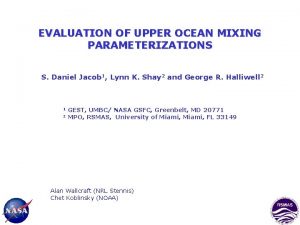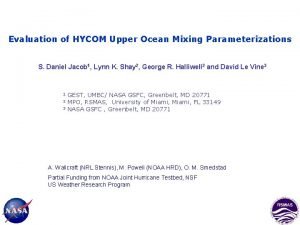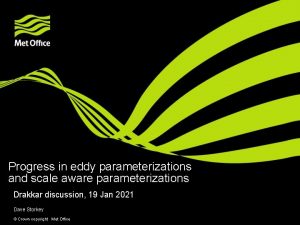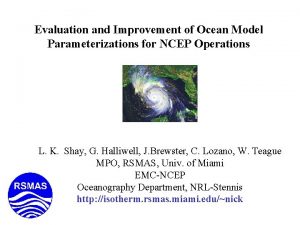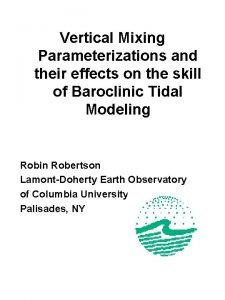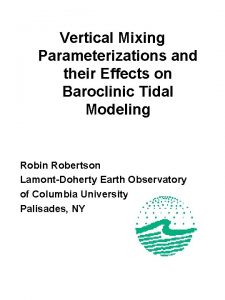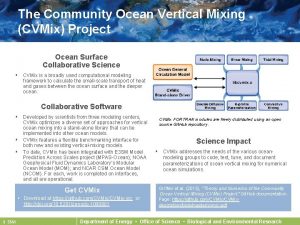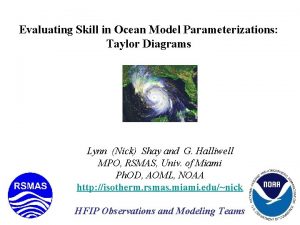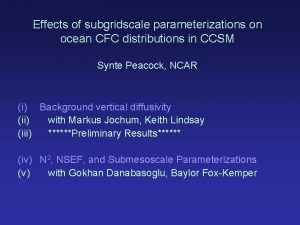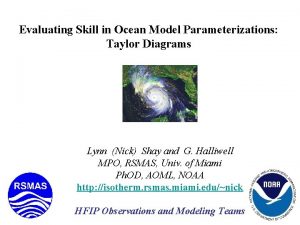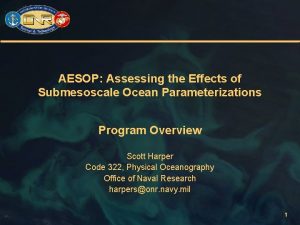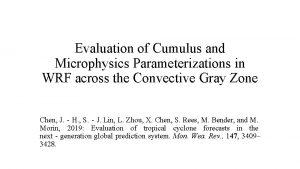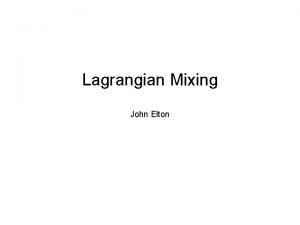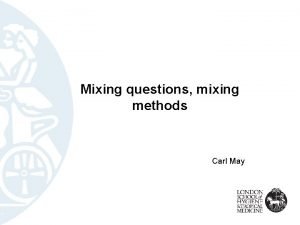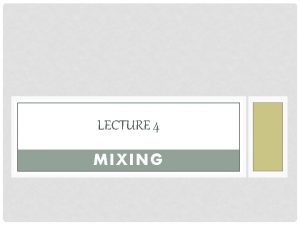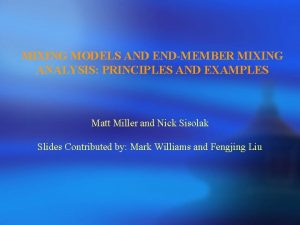Evaluation of Upper Ocean Mixing Parameterizations S Daniel




















- Slides: 20

Evaluation of Upper Ocean Mixing Parameterizations S. Daniel Jacob 1, Lynn K. Shay 2 and George R. Halliwell 2 1 2 3 GEST, UMBC/ NASA GSFC, Greenbelt, MD 20771 MPO, RSMAS, University of Miami, FL 33149 NASA GSFC , Greenbelt, MD 20771 FOCUS: EMC Coupled Intensity Prediction Modeling Acknowledgements: 1. A. Wallcraft (NRL Stennis), M. Powell (NOAA HRD), O. M. Smedstad (Planning Systems Inc), David Le. Vine (NASA/GSFC), 2. TPC Points of Contact: Michelle Mainelli and Miles Lawrence

Upper Ocean Mixing and Hurricane Intensity • Based on Observational Analysis (Jacob et al. , JPO 2000) – Entrainment is the dominant mechanism in the mixed layer cooling. – Mixed layer heat and mass budgets strongly depend upon the entrainment scheme used. • Numerical Modeling (Jacob and Shay, JPO, 2003): – Measured and simulated quantities based on different hypothesis are used to compute entrainment mixing. – Four bulk or slab schemes in using MICOM

MOVIE 1 Gaspar KT PRT DDF

Gaspar MY 2. 5 Hycom Q Movie KPP PWP

No Precip 2 Rmax Precip

OBJECTIVES Evaluate and Validate Mixing Schemes to identify the most appropriate parameterizations for use in coupled prediction model. l Schemes in the Hybrid Coordinate Ocean Model • • • K Profile Parameterization (Large et al. 1994) Gaspar (1988) Price et al. (1986) scheme. Mellor and Yamada (1974) Level 2. 5 scheme Canuto et al. (2001, 2002) l Compare Simulations to Observations • • • Gilbert (1988) Isidore (2002) Lili (2002) 353 Temperature Profiles from AXBTs, AXCPs and AXCTDs 208 Current Profiles from AXCPs 102 Salinity Profiles from AXCTD

GILBERT UPPER OCEAN RESPONSE EXPERIMENT Shay et al. JGR 1992

ISIDORE 60 AXBTs 77 AXCPs 70 AXCTDs Shay and Uhlhorn Poster

LILI 83 AXBTs 57 AXCPs 32 AXCTDs

Model Configurations l Gilbert (1988): l Prior HYCOM/ MICOM configuration on Mercator grid at 0. 07° resolution at the equator. l Closed/ Buffer Zone at the boundaries. l Simulations from 14 Sep 1988 to 20 Sep 1988. l Isidore (2002) and Lili (2002): l Domain includes Caribbean Sea and the Gulf of Mexico. l Treated as a single case with 20 day integration for each mixing parameterization. l Configured as a nest of the basin scale HYCOM that provides conditions at the open boundaries.

Initial Conditions • Gilbert • Initial Conditions derived from Yearday 200 data in 1988 • Eddy location is accurate to 0. 2° • Strength of the Eddy is consistent with Observations • Depth of the 26° C isotherm is about 10 m shallower • Pre-Isidore conditions are derived from the Basin Scale HYCOM • Altimeter data assimilated – Gulf Stream/LC located correctly • Depth of the 26° C isotherm is shallower in these fields • Detailed evaluation Poster by Dr. Halliwell et al.

Sea Surface Height Field Temperature-Salinity Diagram LCW GCW

Sea Surface Height Anomaly and Ocean Heat Content 19 Sept 2002

WIND FIELD STRUCTURE 16 SEP 88 06 UTC HWIND Analysis • Flight Level Reduced • Buoy • ECMWF • 3 Hourly

WIND FIELD STRUCTURE 22 SEP 02 12 UTC • 3 hourly Inner Core Winds from Dr. M. Powell, HRD • NCEP Winds • Resample to 1 Hr

KPP PWP MY GISS

KPP: Gaspar: y = 1. 05 x – 1. 75 d = 0. 28° C σd = 1. 19° C y = 0. 68 x + 9. 0 d = -0. 40° C σd = 0. 94° C PWP: MY: y = 1. 40 x – 12. 2 d = 1. 52° C σd = 2. 30° C y = 0. 94 x + 1. 68 d = -0. 14° C σd = 1. 12° C GISS: y = 1. 18 x - 5. 4 d = 0. 56° C σd = 1. 38° C

KPP GISS

SUMMARY • Two High Resolution HYCOM configurations are used to investigate the oceanic mixing parameterizations for use in coupled predictive models with a EMC focus. • Initial conditions and forcing for the three cases compare well with the observed data. • Simulations suggest that the KT scheme simulates warmer mixed layers in contrast PWP scheme that is much cooler. The higher order schemes perform in the middle in all cases. • Comparisons with data indicates better performance of KPP and MY 2. 5 for the Gilbert case. Initial comparisons indicate a slightly better statistics for the KPP scheme in Isidore and Lili cases. • Further comparison and investigation of sensitivity to vertical resolution of the model is in progress. Initial simulations in the Gilbert case do not show much sensitivity, although oceanic mixed layer depth is resolved better with higher resolution.

Future Work • Detailed comparison and sensitivity of the comparison statistics to the vertical resolution of the model for Isidore and Lili cases. • Comparison of – – Mixed Layer Depths Currents Shear/ Richardson Numbers/ Diffusivities Salinity dependant stability • TRANSITION – with NCEP deploying HYCOM operationally as the ocean component, this is straight forward. • Only three storms – Additional measurements and further validation required to improve confidence. • A post-season evaluation of the model fields is necessary. Requires operational ocean response observations in the near future to improve statistical base of comparisons.
 Ocean ocean convergent boundary
Ocean ocean convergent boundary Red ocean strategi
Red ocean strategi Divergent vs convergent boundaries
Divergent vs convergent boundaries Chapter 15 ocean water and ocean life wordwise answer key
Chapter 15 ocean water and ocean life wordwise answer key Ocean ocean convergent boundary
Ocean ocean convergent boundary Sciencechannel.com/activate
Sciencechannel.com/activate Convergent plate boundaries
Convergent plate boundaries Ocean to ocean convergent boundary
Ocean to ocean convergent boundary Mixing methods of yeast breads
Mixing methods of yeast breads Exercise 38 review sheet art-labeling activity 1 (2 of 2)
Exercise 38 review sheet art-labeling activity 1 (2 of 2) Counterseasonal product and service mixing
Counterseasonal product and service mixing Water vapor mixing ratio
Water vapor mixing ratio Ramco super plaster mixing ratio
Ramco super plaster mixing ratio Is mixing kool aid a chemical change
Is mixing kool aid a chemical change Turbulent flow equation
Turbulent flow equation Cutting and mixing
Cutting and mixing Herbicide mixing cheat sheet
Herbicide mixing cheat sheet Double spotting in superheterodyne receivers is caused by
Double spotting in superheterodyne receivers is caused by Conservative mixing
Conservative mixing A worker mixing chemicals must not wear
A worker mixing chemicals must not wear Single use mixing system
Single use mixing system









